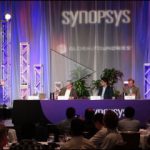Most everybody is familiar with the term Trojan Horse, drawn from Greek mythology. It’s a tale from the Trojan War where, after a fruitless 10-year attempt to capture the city of Troy, the Greeks constructed a huge wooden horse, left it outside the city walls, and then sailed away, seemingly accepting defeat. The Trojans were elated,… Read More
Tag: internet of things
Can one flow bring four domains together?
IoT edge device design means four domains – MEMS, analog, digital, and RF – not only work together, but often live on the same die (or substrate in a 2.5D process) and are optimized for power and size. Getting these domains to work together effective calls for an enhanced flow.
Historically, these domains have not played together … Read More
There is more than C to worry about
We periodically see that “software ate the world” line – I’m pretty sure I’ve used it a couple times myself. The fact is, software doesn’t run itself; never has, never will. Somewhere there has to be an underlying computer. First it was on beads, then in gears, then in tubes.… Read More
Developing Countries – Unlikely Champions of IOT
When considering any new or emerging technology, it can be easy to immediately think of the potential implementation in developed markets. After all, these are the markets where consumers have high purchasing power, and businesses and governments have strong credit lines and funding options. Well, wouldn’t it be a surprise … Read More
IOT Security – Ongoing Challenge
It is near impossible to read or have a conversation about IoT, without security becoming a major topic. For IT professionals involved with IoT projects, security needs to be a major consideration, starting with planning and design, and continuing all the way through to deployment, implementation, and maintenance. Security… Read More
IoT Standardization and Implementation Challenges
The rapid evolution of the IoT market has caused an explosion in the number and variety of IoT solutions. Additionally, large amounts of funding are being deployed at IoT startups. Consequently, the focus of the industry has been on manufacturing and producing the right types of hardware to enable those solutions. In current model,… Read More
Five Ways IoT is Changing Trends in Cognitive Business
How is the Internet of Things, or IoT, changing trends in cognitive business? The impact is evident with the alliance between computers and humans. Computers still quickly assimilate and spew out data based on what is seen, heard and read. The difference is that they are now reasoning, understanding, and learning from those processes,… Read More
Optimization and verification wins in IoT designs
Designers tend to put tons of energy into pre-silicon verification of SoCs, with millions of dollars on the line if a piece of silicon fails due to a design flaw. Are programmable logic designers, particularly those working with an SoC such as the Xilinx Zynq, flirting with danger by not putting enough effort into verification?… Read More
Semi execs look at IoT tradeoffs a bit differently
What happens when you get a panel of four executives together with an industry-leading journalist to discuss tradeoffs in IoT designs? After the obligatory introductions, Ed Sperling took this group into questions on power, performance, and integration.… Read More
How Connected Healthcare is Becoming Vital
There is one word that describes the direction that the health care industry is heading, “connectivity”. This catch all term is used to describe using the internet to increase the reach of medicine. This is also known as the internet of things (IOT) and it is nothing new. It is however relatively new to healthcare.
The goal of connected… Read More




